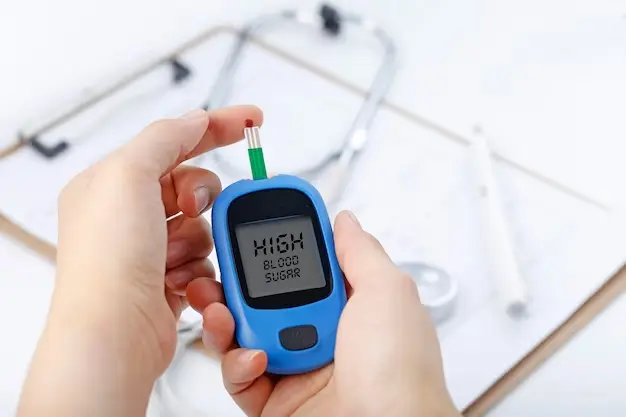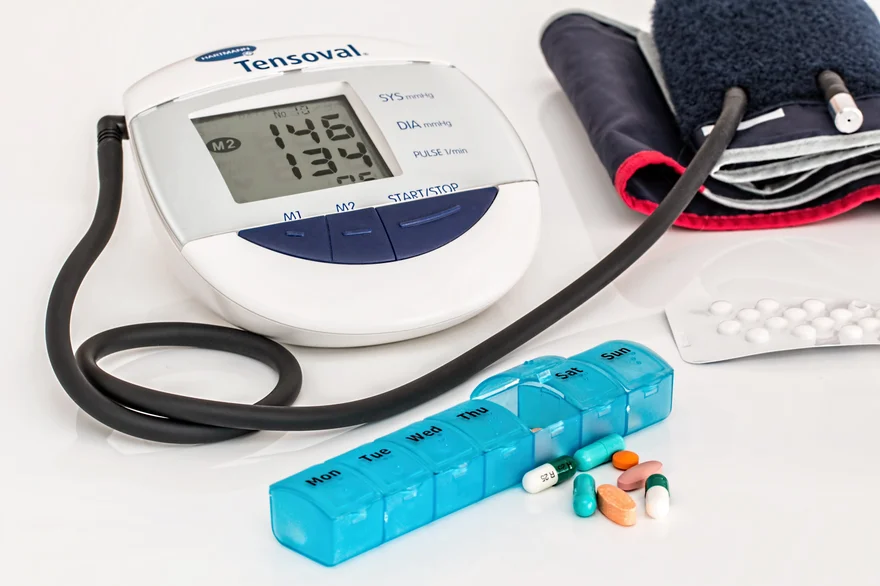Preventive Healthcare
Understanding Prediabetes: The Borderline Zone of Diabetes Risk
1965 Views
0

Prediabetes is an often overlooked transitional phase between health and the risk of diabetes. Most people are unaware of this condition as its symptoms are often not noticeable. Therefore, in this guide, learn everything you need to know about prediabetes, understand the implications, risk factors, and, most importantly, effective strategies to manage and prevent its progression. So, read on!
What is Prediabetes?
Prediabetes is a health condition in which your blood sugar levels are higher than normal but not yet high enough to be diagnosed as Type 2 diabetes. It serves as a warning sign, indicating an increased risk of developing diabetes, cardiovascular diseases, and several other disorders like nephropathy, neuropathy, etc., as you exhibit insulin resistance, wherein your body's cells do not respond effectively to insulin.
The normal fasting glucose level is usually between 70 and 99 milligrams per deciliter (mg/dL). A fasting blood sugar level between 100 and 125 mg/dL indicates the prediabetic range.
How Common is Prediabetes?
Prediabetes is a very common health condition globally. It is estimated that about 7-8 % of the global adult population will be affected by prediabetes by the year 2045 (close to 587 million individuals). In India, about 10 to 15% of the population suffers from prediabetes. Moreover, many are unaware of their condition, as prediabetes symptoms are not seen in most cases.
What are the Common Symptoms of Prediabetes?
Some common symptoms are:
- No Symptoms (Asymptomatic): Prediabetes symptoms are often not noticeable symptoms, making regular screenings important for early detection.
- Increased Thirst and Hunger: You may experience heightened thirst and hunger as a symptom of prediabetes as your body struggles to regulate blood sugar levels.
- Frequent Urination: Elevated blood sugar can lead to increased urination, which is a common diabetes and prediabetes symptom.
- Fatigue: Prediabetes symptoms may also include fatigue as you may feel more tired than usual, reflecting the body's struggle with insulin resistance.
- Blurred Vision: Fluctuating blood sugar levels can affect your eyes, causing temporary blurriness.
What Causes Prediabetes?
Here are some of the causes of prediabetes:
- Insulin Resistance: With insulin resistance, your body's cells become less sensitive to the effects of insulin, impairing their ability to absorb glucose from your bloodstream efficiently. As a result, your pancreas compensates by producing more insulin in an attempt to lower blood sugar levels. However, over time, this increased demand on the pancreas can exhaust its capacity to produce sufficient amounts of insulin, leading to persistently high blood sugar levels.
- Increased Metabolic Disturbance: One consequence of high blood sugar is increased oxidative stress, which occurs when there is an imbalance between the production of Reactive Oxygen Species (ROS) and your body's ability to neutralise them with antioxidants. Over time, this oxidative stress contributes to the development and progression of various complications associated with diabetes, including cardiovascular disease, kidney dysfunction, and nerve damage.
What are the Risk Factors for Prediabetes?
Some of the risk factors for prediabetes are:
- Age: The risk of prediabetes increases with age, particularly after 45.
- Family History: A family history of diabetes raises the likelihood of prediabetes, suggesting a genetic predisposition.
- Obesity: Excess body weight, especially abdominal fat, is a significant risk factor, often leading to insulin resistance. It can also be a symptom of prediabetes.
- Physical Inactivity: Lack of regular exercise contributes to weight gain and insulin resistance.
- Unhealthy Diet: Diets high in refined sugars, carbohydrates, and saturated fats contribute to insulin resistance and prediabetes.
- Gestational Diabetes: Women who had gestational diabetes during pregnancy are at an increased risk.
- Polycystic Ovary Syndrome (PCOS): Women with PCOS are at a higher risk of prediabetes.
- Hypertension: High blood pressure is often associated with insulin resistance and prediabetes.
- Sleep Disorders: Conditions like sleep apnea can contribute to insulin resistance and increase your prediabetic glucose levels.
- Stress: Chronic stress can contribute to insulin resistance, affecting blood sugar levels and increasing the risk of prediabetes.
What are the Possible Complications of Prediabetes?
Prediabetes poses risks for various health complications if you leave it untreated. The condition increases the likelihood of developing Type 2 diabetes, heart disease, and stroke. Additionally, prediabetes is associated with metabolic syndrome, characterised by elevated blood pressure, abnormal cholesterol levels, and abdominal obesity. These complications escalate the risk of kidney disease, vision problems, and nerve damage in your body.
How is Prediabetes Diagnosed?
Prediabetes is diagnosed through specific blood tests that measure your glucose levels, providing crucial insights into your body's ability to regulate blood sugar. The primary diagnostic tests include:
- Fasting Blood Sugar Test (FBS): This involves measuring your blood sugar levels after an overnight fast. A reading between 100 and 125 mg/dL indicates prediabetes, signalling impaired glucose regulation in your body.
- Oral Glucose Tolerance Test (OGTT): After fasting overnight, you consume a glucose-rich solution. Your blood sugar levels are then tested two hours later. Readings between 140 and 199 mg/dL suggest prediabetic glucose levels, indicating your body's struggle to manage glucose effectively.
- Haemoglobin A1c Test: This test provides a comprehensive view of average blood sugar levels over the past two to three months. An A1c level between 5.7% and 6.4% is indicative of prediabetes.
How Can I Reverse Prediabetes?
Reversing prediabetes involves making significant lifestyle changes to improve your insulin sensitivity and blood sugar regulation. Here are key steps that may help in reversing prediabetes:
- Balanced Diet: Focus on a well-balanced diet for prediabetes that includes a variety of whole foods such as fruits, vegetables, lean proteins, whole grains, and healthy fats. Limit the intake of processed foods, sugary snacks, and refined carbohydrates.
- Portion Control: Be mindful of portion sizes to avoid overeating and maintain a healthy weight.
- Exercise Routine: Engage in regular physical activity, aiming for at least 150 minutes of moderate-intensity aerobic exercise per week. This can include activities like brisk walking, jogging, cycling, or swimming.
- Strength Training: Incorporate strength training exercises at least twice a week to build muscle mass, which can enhance insulin sensitivity.
- Gradual Weight Loss: Aim for gradual and sustainable weight loss if overweight. Losing even a modest amount of weight, such as 5-10% of your total body weight, can significantly improve insulin sensitivity.
- Consultation with a Nutritionist: Seek guidance from a nutritionist or dietitian to create a personalised prediabetes diet plan that supports weight management and blood sugar control.
- Hydration and Limiting Sugary Beverages: Stay well-hydrated by drinking plenty of water throughout the day. Limit the consumption of sugary beverages, as they can contribute to blood sugar spikes.
- Quality Sleep: Ensure you get enough high-quality sleep each night. Poor sleep patterns can affect insulin sensitivity and contribute to the development of prediabetes.
- Relaxation Techniques: Practice stress-reducing techniques such as meditation, deep breathing exercises, or yoga. Chronic stress can contribute to insulin resistance, so managing stress is crucial for reversing prediabetes.
- Blood Sugar Checks: Regularly monitor blood sugar levels as your healthcare provider recommends. This helps track progress and ensures early detection of any changes.
- Sustainable Changes: Aim for lifestyle changes that are sustainable in the long term. Avoid crash diets or extreme exercise regimens, as they may not be maintainable over time.
Can You Take Medication for Prediabetes?
While lifestyle changes are the primary approach for prediabetes treatment, some doctors may prescribe medications in certain cases. Medication may be considered when lifestyle modifications alone are insufficient for prediabetes treatment. Common medication like metformin helps lower your blood sugar levels.
Can I Prevent Prediabetes?
Yes, you can easily prevent prediabetes through lifestyle changes. Adopt a healthy diet rich in fruits, vegetables, and whole grains, engage in regular physical activity and maintain a healthy weight. You should avoid excessive sugar and processed foods as well as stay away from smoking as much as possible.
What Can I Expect If I Have Prediabetes?
If you have prediabetes, you might struggle to maintain your glucose levels throughout the day. A constant lack of energy while doing normal day-to-day activities is another aspect of having prediabetes. Therefore, once you are diagnosed with prediabetes, it is advisable to meticulously follow a well-rounded lifestyle and avoid foods with a high glycemic index. This keeping a check on your food intake will reduce the chances of your prediabetes progressing to Type 2 Diabetes.
How Do I Take Care of Myself If I Have Prediabetes?
You can take care of yourself and reverse prediabetes by incorporating healthy habits into your routine. Here's a sample daily plan:
Morning
- Breakfast (9 am -10 am)
- Include a balanced breakfast with whole grains (oatmeal, whole wheat toast), lean protein (eggs, yoghurt), and fruits.
- Hydrate with water or herbal tea.
- Exercise (6 am - 7 am)
- Engage in 30 minutes of moderate-intensity aerobic exercise, such as brisk walking or cycling.
- Consider incorporating strength training exercises.
Afternoon
- Lunch (1 pm - 2 pm)
Opt for a well-balanced lunch with lean proteins (chicken, fish, tofu), plenty of vegetables, and a small portion of whole grains.
- Snack (4 pm -5 pm)
Choose a healthy snack, such as a handful of nuts, greek yoghurt, or raw vegetables.
- Stress Management
Take a short break to practice stress-reducing techniques like deep breathing or a brief walk.
Evening
- Dinner (8 pm - 9 pm)
- Consume a dinner rich in vegetables, lean proteins, and a modest serving of whole grains.
- Avoid heavy, late-night meals.
- Post-Dinner Activity
- Take a short walk or engage in light activity to aid digestion.
- Avoid excessive screen time before bedtime.
Sleep Hygiene
- Aim for 7-9 hours of quality sleep.
- Establish a consistent sleep routine.
Throughout the Day
Hydration
- Drink plenty of water throughout the day.
- Limit or avoid sugary beverages.
Weekly
Meal Planning: - Plan and prepare meals ahead for the week, focusing on nutritious options.
Monthly:
- Health Check-Up: Schedule regular health check-ups to monitor overall health, blood pressure, and cholesterol levels.
- Education: Stay informed by reading reputable sources or attending educational programs about prediabetes.
When Should I See My Healthcare Provider?
You can consider scheduling an appointment with your healthcare provider if you are experiencing symptoms of prediabetes like increased thirst or frequent urination or if you are losing weight without any physical activity or diet. The American Diabetes Association recommends regular prediabetes/diabetes screening in your 30s or when you see visible symptoms.
What Questions Should I Ask My Healthcare Provider About Prediabetes?
Some of the common questions to ask are:
- What is my current blood sugar level, and what does it indicate about my prediabetes risk?
- What lifestyle changes can I make to manage prediabetes effectively?
- What is my healthy target weight, and how can I achieve it?
- Should I consider medications to manage prediabetes, and what are their potential benefits and side effects?
- How often should I monitor my blood sugar levels, and what is the target range?
- What to eat for prediabetes, and can I consult a nutritionist for personalised advice on a prediabetes diet?
- What types of exercises are most beneficial for managing prediabetes, and how often should I engage in physical activity?
- What other health screenings or tests should I undergo regularly?
- Are there any signs or prediabetic symptoms I should be particularly attentive to?
Conclusion
Managing prediabetes requires you to have a proactive approach involving lifestyle changes and regular monitoring. By adopting a healthy diet, engaging in regular physical activity, and addressing risk factors, you can easily reverse prediabetes and reduce the risk of progression to Type 2 diabetes. Early intervention and education are pivotal for preventing complications associated with prediabetes. Are you looking to take that early step and get yourself tested for prediabetes? If so, book your blood sugar test with Metropolis Labs, a leading pathology service provider with cutting-edge lab technology and a commitment to precision that ensures accurate blood sugar insights to manage your health proactively. Book your slot today!























 WhatsApp
WhatsApp